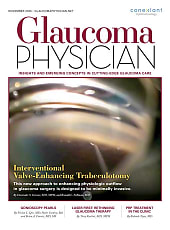With the category of minimally invasive glaucoma surgeries (MIGS) expanding rapidly in recent years, Constance Okeke, MD, MSCE, a glaucoma and cataract specialist at Virginia Eye Consultants, Norfolk, Virginia and assistant professor of Ophthalmology, Eastern Virginia Medical School, researched the factors that go into a successful procedure. Her presentation Friday morning, “Practical Tips for Minimally Invasive Glaucoma Therapy,” offered the practical pearls surgeons need to know to produce optimal outcomes with MIGS.
“When we think about success in MIGS, not only is patient selection important but also mastering surgical techniques so that you can have good outcomes,” said Dr. Okeke, author of The Building Blocks of Trabectome Surgery - Patient Selection.
She offered pearls for MIGS generally, as well as ones tailored to the 6 classes of mechanism of action in MIGS.
For the surgery overall, Dr. Okeke emphasized the importance of wound hydration to ensure the anterior chamber is firm and taut. “This helps with reducing hyphema postoperatively, as well as using Shugarcaine [MSK Pharma] as a vasoconstrictor right at the end of the case to again help with it.”
A second pearl is that Dr. Okeke places a bandage contact lens routinely on all MIGS cases. “Sometimes with use of the gonioprism you can get abrasions on the corneal surface,” she explained. “It really allows for faster healing and extra comfort for the patient.” Additional she uses Dextenza (Ocular Therapeutix) insert for inflammatory control and ocular surface support.
When addressing the pearls for specific mechanisms of action, she offered this one for goniotomy: “It's really important to get a good en face view,” she said. “One cannot underestimate the importance of getting a good setup because, especially with goniotomy, you need to have an excellent wide area of view in order to perform well. If the view is not set up well, it just makes the procedure much more difficult.”
For trabeculotomy, Dr. Okeke said the pearl for this type of MIGS “is to move slow, steady and deliberate,” she said. “Also, feel and watch because when you're doing this procedure there are areas where you can see and areas where you cannot.”
To reduce those “blind” areas, she recommended moving the gonioscope around to see as much as possible. For the areas that still could not be seen, Dr. Okeke emphasized proceeding very slowly and being mindful of any change to the patient’s grimace that might indicate discomfort when the catheter may be in the wrong space. “Be mindful of any kind of resistance because you don't also want to just push through resistance, as that can also lead to complications.”
Dr. Okeke called superciliary MIGS, a “very exciting area” because since the CyPass (Alcon) was recalled in 2018 the glaucoma community has been waiting for a device for this space. With that wish finally granted with the delivery of Alloflo Uveo, she offered some pearls about obtaining heme and pain control.
“Shugarcaine can help you to anesthetize the eye so that you can actually do the procedure under topical, but it also helps reduce bleeding because the epinephrine acts as a vasoconstrictor” during the procedure, she explained.
For subconjunctival MIGS, Dr. Okeke said, “It's really important to create a pocket with anti fibrotic and that pocket is where the tip of the Xen [AbbVie] should be and be allowed to flow. If you work in the surgery to make a good pocket, this helps in not having to have as much work in the clinic with a lot of needling.”
Mastering MIGS, Dr. Okeke concluded, requires not only understanding which device to choose, but also knowing how to optimally use it. “As we continue to expand in MIGS and have more options, we really need to make sure we're learning how to be precise, to plan well, and continuously learn how to master the surgical techniques.” She offers continued learning with more videos on her iGlaucoma YouTube Channel. GP








